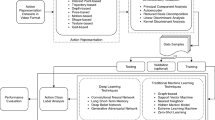Abstract
Recent days have stamped enormous upsurge about health awareness in society. Self tutoring systems for supervising the performed exercises offer numerous advantages and are therefore emerging as an entity of dire necessity in health-sector. Considering the significantly increasing global acceptance of ‘\({{Yog\bar{a}sana}}\)’ as one of the most preferred exercise, this paper proposes a novel and an intelligent vision-based self-tutoring system for \({{Yog\bar{a}sana}}\). The proposed system, ’e-YogaGuru’ analyzes the body movements while performing \({{Yog\bar{a}sana}}\), provides feedback about its correctness and further, suggests amendment, if required. Incorporation of angle features in the novel state transition-based approach addresses the earlier reported issues raised due to human anthropometry and variance in the execution speed. Consideration of hold time and suggestion of amendment at two levels, abstract level and detailed amendment (sequences of pre-posture, main-posture and post-posture), make the proposed e-YogaGuru unique and efficient. System is trained for 21 postures derived from the skeleton stream of 8 experts exhibiting variations in anthropometry and execution speed (Knowledge base). A dataset composed of 1750 video sequences (7 \({{Yog\bar{a}sana}}\) performed by 25 practitioners) is used to validate the efficacy of the devised approach. The proposed e-YogaGuru achieved 98.29 % accuracy in correctly identifying the \({{Yog\bar{a}sana}}\) and has been able to suggest required amendment in the incorrectly performed \({{Yog\bar{a}sana}}\) with an accuracy of 96.34 %. Proposed ‘e-YogaGuru’ incorporates significant parameters (hold time and amendment) and achieves appreciable accuracies, thus it not only out-performs the earlier reported systems but also marks a long bounce towards practical deployment.





Similar content being viewed by others
References
Aggarwal, J.K., Cai, Q., Liao, W., Sabata, B.: Nonrigid motion analysis: articulated and elastic motion. Comput. Vis. Image Understand. 70(2), 142–156 (1998)
Aggarwal, J.K., Ryoo, M.S.: Human activity analysis: a review. ACM Comput. Surv. 43(3), 16 (2011)
Barnachon, M., Bouakaz, S., Boufama, B., Guillou, E.: A real-time system for motion retrieval and interpretation. Pattern Recognit. Lett. 34(15), 1789–1798 (2013)
Chen, H. T., He, Y. Z., Hsu, C. C., Chou, C. L., Lee, S. Y., Lin, B.S.P.: Yoga posture recognition for self-training. In: International Conference on Multimedia Modeling (pp. 496–505). Springer, Cham (2014)
Field, T.: Yoga clinical research review. Complement. Therapies Clin. Pract. 17(1), 1–8 (2011)
Gavrila, D.M.: The visual analysis of human movement: a survey. Comput. Vis. Image Understand. 73(1), 82–98 (1999)
Gonzalez, A.J., Ingraham, L.R.: Automated exercise progression in simulation-based training. IEEE Trans. Syst. Man Cybern. 24(6), 863–874 (1994)
Iyengar, B.K.S.: The illustrated light on yoga. Orient BlackSwan (2011)
Kale, G.V., Patil, V.H.: A study of vision based human motion recognition and analysis. Int. J. Ambient Comput. Intell. 7(2), 75–92 (2016)
Kauts, A., Sharma, N.: Effect of yoga on academic performance in relation to stress. Int. J. Yoga 2(1), 39 (2009)
Luo, Z., Yang, W., Ding, Z. Q., Liu, L., Chen, I. M., Yeo, S. H., Duh, H.B.L.: Left Arm Up! Interactive Yoga Training in Virtual Environment. In: 2011 IEEE Virtual Reality Conference (pp. 261–262). IEEE (2011)
Poppe, R.: Vision-based human motion analysis: an overview. Comput. Vis. image Understand. 108(1–2), 4–18 (2007)
Su, C.J.: Personal rehabilitation exercise assistant with kinect and dynamic time warping. Int. J. Inf. Edu. Technol. 3(4), 448–454 (2013)
Wang, P., Li, W., Ogunbona, P., Wan, J., Escalera, S.: RGB-D-based human motion recognition with deep learning: a survey. Comput. Vis. Image Understand. 171, 118–139 (2018)
Watanabe, Y., Yamada, Y., Yokoyama, K., Yoshida, T., Yoshinaka, Y., Yoshimoto, M., Ishikawa-Takata, K.: Comprehensive geriatric intervention program with and without weekly class-style exercise: research protocol of a cluster randomized controlled trial in Kyoto-Kameoka Study. Clin. Intervent. Aging 13, 1019 (2018)
Williams, K.A., Petronis, J., Smith, D., Goodrich, D., Wu, J., Ravi, N., Steinberg, L.: Effect of Iyengar yoga therapy for chronic low back pain. Pain 115(1–2), 107–117 (2005)
Wu, W., Yin, W., Guo, F.: Learning and self-instruction expert system for Yoga. In: 2010 2nd International Workshop on Intelligent Systems and Applications (pp. 1–4). IEEE (2010)
Yao, L., Xu, H., Li, A.: Kinect-based rehabilitation exercises system: therapist involved approach. Bio Med. Mater. Eng. 24(6), 2611–2618 (2014)
Zimmerman, J.: U.S. Patent Application No. 10/358,396 (2004)
Zhao, W., Lun, R., Espy, D. D., Reinthal, M.A.: Rule based realtime motion assessment for rehabilitation exercises. In: 2014 IEEE Symposium on Computational Intelligence in Healthcare and e-health (CICARE) (pp. 133–140). IEEE (2014)
Author information
Authors and Affiliations
Corresponding author
Additional information
Publisher's Note
Springer Nature remains neutral with regard to jurisdictional claims in published maps and institutional affiliations.
Rights and permissions
About this article
Cite this article
Kale, G., Patil, V. & Munot, M. A novel and intelligent vision-based tutor for Yogāsana: e-YogaGuru. Machine Vision and Applications 32, 23 (2021). https://doi.org/10.1007/s00138-020-01141-x
Received:
Revised:
Accepted:
Published:
DOI: https://doi.org/10.1007/s00138-020-01141-x




